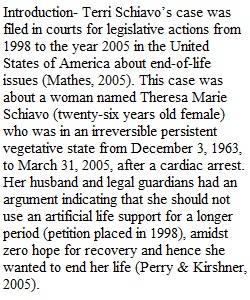


Q CHOOSE YOUR CASE: So far in the course, you have studied many of the principles, theories, and applications of ethics. Now you will apply what you have learned to one of two case analyses. You will choose between the case of Dax Cowart and the case of Terri Schiavo. Review the description for both so as to choose the one that most interests you. To analyze your chosen case, you will use scholarly resources and the knowledge you’ve gained from the course so far to support your work. Your case analysis should be 5 pages in length (not counting title page). It will include the following: • A title page with the title of the case, your name, and date • Double-spaced, Times New Roman 12-point font • APA formatted inline citations as appropriate • A bibliography of references used Be sure to use the readings below to complete this assignment. While you are welcome to use other sources as well, it is not necessary. ________________________________________ CASE 1: The Case of Terri Schiavo Introduction We will use case analysis to extend our examination of patient autonomy with one of the earliest cases surrounding patient rights and patient autonomy. Although the case of Terri Schiavo have tested the balance of decision making when patients may no longer speak for themselves. Instructions Before writing your case analysis, make sure you have gone through the readings associated with the Schiavo Case Analysis. The articles listed below are provided to assist you with completing the assignment. While you are welcome to use other sources as well, it is not necessary. o The Module Notes of Modules 1 – 4 o Cyranoski, D. (2012). The mind reader. Nature, 456, 178-180. o Ditto, P. (2006). What would Terri want? On the psychological challenges of surrogate decision makingLinks to an external site.. Death Studies. 30(2), 135-148. Retrieved on October 13, 2010 from Academic Search Premier database o Fins, J. (2009). Brain injury: the vegetative and minimally conscious statesLinks to an external site.. Garrison, NY: The Hastings Center, Bioethics Briefing Book. o Mathes, M. (2005). Terri Schiavo and end-of-life decisions: Can law help us out?Links to an external site. MEDSURG Nursing. 41(3), 200-202. o Perry, J., Chruchill, L. R. & Kirshner, H.S. et al. (2005). The Terri Schiavo case: Legal, ethical, and medical perspectivesLinks to an external site.. Annals of Internal Medicine. 143(10), 744-748. o Terri Schiavo Documentary: The Case's Enduring Legacy | Retro Report | The New York TimesLinks to an external site. After reviewing the case study articles, respond to the following questions: 1. Provide a brief introduction of the Terri Schiavo case. 2. Identify at least two ethical issues that relate to this dilemma. 3. Identify the at least five stakeholders and briefly describe the situation from their perspective. 4. Analyze the dilemma from the perspective of the healthcare professional, applying one of the frameworks that are discussed in the module or one that you may use in your professional work. Be sure to address each element. 5. Identify a more recent case involving patient decision making when they are no longer able. After providing a brief introduction to the case, identify some of the similarities and differences. In what ways has Schiavo’s case impacted this case? Explain what types of policies, procedures, standards have been put in place to assist in preventing such a dilemma. 6. Briefly discuss what you have learned from your exploration of the Terri Schiavo case. Has the case influenced your view of advanced directives? Presuming you have not already, are you now considering completing your own advance directives? Why or Why Not? ________________________________________ Compose your work in a .doc or .docx file type using a word processor (such as Microsoft Word, etc.). Check your work and correct any spelling or grammatical errors. This assignment uses Turnitin. Evaluation This assignment will be graded using the HSC 312 Case Study Rubric located on the Rubrics page within the Course Introduction module of the course. Please review the rubric prior to beginning your work so that you ensure your submission meets the criteria in place for this assignment. This is one of three written assignments, which are combined worth 55% of your final course grade.
View Related Questions